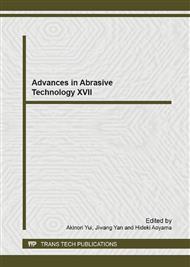p.141
p.147
p.154
p.160
p.166
p.175
p.181
p.187
p.193
Evaluation and ANN-Based Prediction on Functional Parameters of Surface Roughness in Precision Grinding of Cast Iron
Abstract:
Three-dimensional surface roughness parameters are widely applied to characterize frictional and lubricating properties, corrosion resistance, fatigue strength of surfaces. Among them, the functional parameters of surface roughness, such as Sbi, Sci, and Svi, are used to evaluate bearing and fluid retention properties of surfaces. In this study, the effects of grinding parameters, including wheel linear speed (Vs), workpiece linear speed (Vw), grinding depth (ap), longitudinal feed rate (fa), and dressing rate (F), on functional parameters were studied in grinding of cast iron. An artificial neural network (ANN) model was developed for predicting the functional parameters of three-dimensional surface roughness. The inputs of the ANN models were grinding parameters (Vs, Vw, ap, fa, F), and the output parameters of the models were functional parameters of surface roughness (Sbi, Sci, Svi). With small errors (e.g MSE = 0.09%, 0.61%, and 0.0014%. ), the ANN-based models are considered sufficiently accurate to predict functional parameters of surface roughness in grinding of cast iron.
Info:
Periodical:
Pages:
166-171
Citation:
Online since:
September 2014
Authors:
Price:
Сopyright:
© 2014 Trans Tech Publications Ltd. All Rights Reserved
Share:
Citation:


